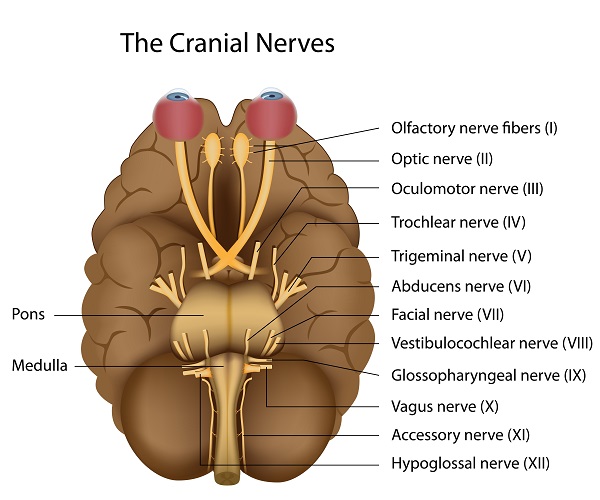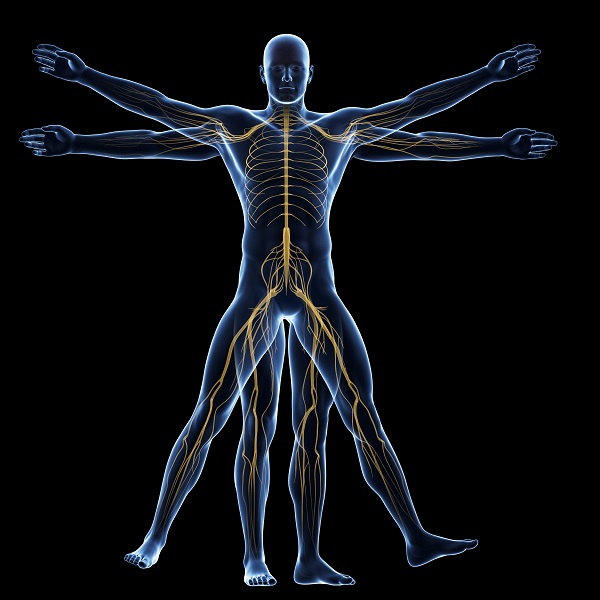It’s All in Your Head: Harnessing the Vagus Nerve to Boost Physical Health
The Mind-Body Connection
If you have ever been startled or scared, like anticipating the drop on a roller coaster, you can appreciate that the mind and body are intimately connected. As the coaster clicked up the ramp, you may have experienced anxiety along with muscle tension, sweaty palms, dry mouth, and an uneasy feeling in your gut (you may even be experiencing these physical symptoms as you recall a past occurrence). Here, you can see the impact a mental/emotional stressor can have on your physical body.
The concept of the mind-body connection—specifically, that afflictions of the mind can contribute to physical ailments, and vice versa—is nothing new. Despite this, Western medicine still tends to observe and treat the body as isolated, independent parts. For example, we see digestive issues treated by looking solely at the gastrointestinal tract, or mental health issues treated by looking exclusively at the chemistry of the brain. However, what happens when irritable bowel syndrome symptoms are made worse by stress? Or when anxiety and depression improve after correcting digestive issues? While the “silo” approach to medicine can be extremely important and helpful in managing symptoms—particularly, urgent ones—it does not take a deeper look at how the body works as a whole to regulate itself and promote health. Thankfully, research is exploring the traditional view of the body being a system of intricately connected parts, working in unison to achieve balance and ultimately support health and longevity. This broadens our understanding of the mind-body connection and sheds light on valuable clinical applications in naturopathic medicine.
There are some very specific examples of the mind-body connection when exploring it from a strictly physical standpoint. Take abdominal epilepsy, where dysfunctional neurological discharges in the brain (which typically manifest in seizures) cause abdominal pain and other digestive complaints. It has also been identified that the composition of the gut microbiome—the various bacteria that populate the digestive tract—can influence mood and emotional wellbeing. However, when we look at the mind-body connection in a broader sense—i.e. how perception, lifestyle habits, attitude, and mindfulness influence physical health—it may not always be as clear. Empirically, it is understood that these habits and practices are probably good for us, but do they actually impact our health positively? The short answer is yes (the long answer resides in the rest of this article).
For those with an inquiring mind, the question then becomes: “How are the mind and body connected?” Followers of traditional Chinese medicine may argue that the answer lies in the various meridian channels running through the body. Practitioners in bioregulatory medicine may argue that the extracellular matrix holds the key. Osteopaths may point to the lymphatic system as the gatekeeper. Functional medicine practitioners may turn their focus to the gut microbiome.
Experience has taught me that there is rarely just one answer to complex mysteries pertaining to human physiology. So, without discounting the possible other mechanisms involved in this process, this article will explore the role of the nervous system in mediating health through the mind-body connection, and what can be done to harness this system to boost physical health.

The Vagus Nerve: Key Player in the Mind-Body Connection
The vagus nerve, the tenth cranial nerve, meanders from its origin in the brainstem, down the neck, and through the chest to the abdomen. By doing so, it creates an important interconnected network between the brain and the digestive system, lungs, heart, liver, and kidneys. While a small portion of this nerve is involved with motor function, the majority of its nerve fibres relay sensory messages to the brain from the organs, so the brain is aware of the state and function of these vital organs.
The vagus nerve plays a major role in regulating parasympathetic activity. Most people are more familiar with sympathetic activity of the nervous system—often referred to as the fight-or-flight response—which represents the other side of the coin. The sympathetic system is the innate response to stressful stimulus that allows us to navigate potentially threatening situations appropriately. For example, if you were driving and a squirrel jumped out onto the road, your sympathetic system would increase its activity to enable a quick and accurate response to keep you—and hopefully the squirrel—safe. Conversely, the parasympathetic nervous system plays a role in relaxation following the stressful event—sometimes called the rest-and-digest response. Balancing these two systems is a foundational pillar of health.
Just as people have individuality in appearance and personality, there is also variability in vagal tone from one person to the next. Vagal tone is an index of parasympathetic activity and is indirectly measured through heart-rate variability in relation to respiration. As one breathes in, the vagus nerve is less active and the heart rate goes up to align the supply of oxygen with the body’s demand. As one breathes out, the vagus nerve is more active and the heart rate slows down. Through this assessment, high vagal tone is represented by a bigger difference in heart rate between inspiration and expiration. Individuals with low vagal tone do not relax as effectively or quickly following stressful events, whereas those with higher vagal tone recover more effectively.
Vagal Tone and Physical Health
The role of vagal tone on cardiac function has been well-documented, but its role in other aspects of health and general allostasis—achieving stability by adjusting our internal systems—is getting more attention.
Evidence suggests that decreased vagal tone has been associated with dysregulated blood-sugar levels (a risk factor for diabetes, cardiovascular disease, stroke, kidney disease, and eye pathologies), increased cortisol levels (a stress hormone and mediator of a number of health concerns), and increased proinflammatory molecules (an underlying mechanism of various chronic degenerative diseases, like heart disease and rheumatoid arthritis). Further research has explored how individuals with low vagal tone who suffered a heart attack have a poorer prognosis, and those with anxiety and depression have increased sympathetic activity.
Due to the large number of organs that the vagus nerve interacts with, low vagal tone has been implicated in a number of complications and disease states. Rather than listing all of the studied and potential health complications associated with low vagal tone, the purpose here is to look further to the fact that they reflect dysfunctions of the body’s regulatory processes, which work behind the scenes to maintain health. It can be thought of in this way: Imagine pollution entering a major river that feeds several streams; focusing on cleaning an individual stream is futile, while benefit can be yielded by looking upstream at the source of issue.

Promoting Optimal Vagal Tone
Vagal tone is regulatory in nature. Given naturopathic medicine’s focus on supporting the body’s ability to attain and maintain balance and heal itself, it is an enticing and important target of therapy.
With the aid of technological advancements, the vagus nerve can be stimulated through the use of an implanted device. This is done in conventional medical settings, and has been used as an adjunctive treatment in epilepsy with mixed results, and in chronic or recurrent treatment–resistant depression with promising results. Further research is exploring its possible use in conditions like schizophrenia, Alzheimer’s disease, obsessive-compulsive disorder, personality disorder, posttraumatic stress disorder, and fibromyalgia. Side effects may occur, which include dry cough induced by speech or mild exercise.
From a naturopathic perspective, several treatment considerations have been examined: yoga, fostering positive emotions and social connections, meditation, deep breathing, and cold exposure. This does not represent an exhaustive list, and there are numerous other ways to harness the vagus nerve for health promotion. However, the majority of individuals can benefit from these strategies and they are not necessarily dependent on medical supervision.
From the body-to-mind side of things, yoga can positively influence vagal tone and GABA regulation (low levels of the neurotransmitter GABA have been associated with anxiety and other neurological issues) to promote improvements in depression, epilepsy, and posttraumatic stress disorder. Looking at the mind-to-body side, vagal tone was increased by reflecting on social connections and generating positive emotions through loving kindness meditation. Additionally, slow, deep breathing (six breaths per minute) has been shown to positively influence vagal tone. This can be accomplished on its own or through yoga practice. Finally, though not always tempting depending on where you live and the time of year, cold exposure causes your body to downregulate the sympathetic response and upregulate the parasympathetic response, mediated by the vagus nerve. Really, any acute exposure to cold can trigger this, but a simple way would be to end your shower with 30 seconds of manageable cold-water exposure. Fortunately, these naturopathic strategies not only benefit vagal tone, but also have additional benefits on physical fitness, attitude, and general wellbeing that the majority of the population can benefit from.
To reiterate, the ultimate goal is to optimize vagal tone to better support the body’s ability to regulate and heal itself. As outlined, individuals with high vagal tone are healthier physically, mentally, and emotionally; they tend to have less cardiovascular disease risk, better concentration and memory skills, more empathy, and closer social connections.
 It is important to be aware that research in this area continues to expand. As such, it is becoming clearer that the role of the vagus nerve in parasympathetic regulation is a component of a broader and more complex model of allostatic balance and health promotion. As mentioned earlier, there is rarely just one answer to a complex question. Therefore, these techniques can be supportive of overall health and wellbeing, but there are numerous other ways to further promote optimal vitality. Your naturopathic doctor can help guide you through the appropriate strategies for your specific needs and goals, and help you realize your full potential.
It is important to be aware that research in this area continues to expand. As such, it is becoming clearer that the role of the vagus nerve in parasympathetic regulation is a component of a broader and more complex model of allostatic balance and health promotion. As mentioned earlier, there is rarely just one answer to a complex question. Therefore, these techniques can be supportive of overall health and wellbeing, but there are numerous other ways to further promote optimal vitality. Your naturopathic doctor can help guide you through the appropriate strategies for your specific needs and goals, and help you realize your full potential.

 Stores
Stores